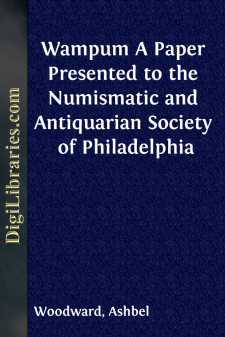Categories
- Antiques & Collectibles 13
- Architecture 36
- Art 48
- Bibles 22
- Biography & Autobiography 813
- Body, Mind & Spirit 142
- Business & Economics 28
- Children's Books 17
- Children's Fiction 14
- Computers 4
- Cooking 94
- Crafts & Hobbies 4
- Drama 346
- Education 46
- Family & Relationships 57
- Fiction 11829
- Games 19
- Gardening 17
- Health & Fitness 34
- History 1377
- House & Home 1
- Humor 147
- Juvenile Fiction 1873
- Juvenile Nonfiction 202
- Language Arts & Disciplines 88
- Law 16
- Literary Collections 686
- Literary Criticism 179
- Mathematics 13
- Medical 41
- Music 40
- Nature 179
- Non-Classifiable 1768
- Performing Arts 7
- Periodicals 1453
- Philosophy 64
- Photography 2
- Poetry 896
- Political Science 203
- Psychology 42
- Reference 154
- Religion 513
- Science 126
- Self-Help 84
- Social Science 81
- Sports & Recreation 34
- Study Aids 3
- Technology & Engineering 59
- Transportation 23
- Travel 463
- True Crime 29
Wampum A Paper Presented to the Numismatic and Antiquarian Society of Philadelphia
by: Ashbel Woodward
Categories:
Description:
Excerpt
WAMPUM.
When Columbus, on his second voyage to the New World, landed upon Cape Cabron, Cuba, the cacique of the adjacent country meeting him upon the shore offered him a string of beads made of the hard parts of shells as an assurance of welcome. Similar gifts were often made to the great discoverer, whenever the natives sought to win his favor or wished to assure him of their own good will. These shell beads were afterwards found to be in general use among the tribes of the Atlantic coast. At the close of the sixteenth century the English colonists found them in Virginia, as did the Dutch at the commencement of the following century in New York, the English in New England and the French in Canada. The pre-historic inhabitants of the Mississippi valley were also evidently acquainted with their manufacture, as remains of shell beads have been found in many of the mounds which survive as the only memorials of that mysterious people.
These Indian beads were known under a variety of names among the early colonists, and were called, wampum, wampom-peage, or wampeage, frequently peage or peake only, and in some localities sewan or zewand. But generally sewan prevailed among the Dutch, and wampum among the English. These names were applied without distinction to all varieties of beads. This confusion arose naturally enough from the scanty acquaintance of the whites with the Indian language. The word wampum [wompam], which has since become a general term, was restricted by the Indians to the white beads. It was derived from wompi, "white." The other or dark beads were called suckáuhock, a name compounded of súcki, "dark colored," and hock, "shell." The name Mowhakes, compounded of mowi, "black," and hock, "shell," was also sometimes applied to the dark beads. It thus appears that the Indians divided their beads into two general classes, the wompam, or white beads, and suckáuhock, or dark beads. Both white and black consisted of highly polished, testaceous cylinders, about one-eighth of an inch in diameter and a quarter of an inch long, drilled length-wise and strung upon fibres of hemp or the tendons of wild beasts. Suckáuhock was made from the stem of the Venus mercenaria, or common round clam, popularly known as the quauhaug; wampum from the column and inner whorls of the Pyrula carica and Pyrula caniculata [Lam.], species known as Winkles or Periwinkles among fishermen, and the largest convoluted shells of our New England coast. These shells were found in great abundance along the sea shore, lying either upon the mud, or just beneath the surface, and were wrought in the following manner. The desirable portions of the shells were first broken out into small pieces of the form of a parallelopiped; these were then drilled and afterwards ground and polished. Possessing no better tools, the Indians made shift to bore them with stone drills, implements which hardly correspond with the delicacy and exactness exhibited by the specimens of original wampum that have come down to us....


